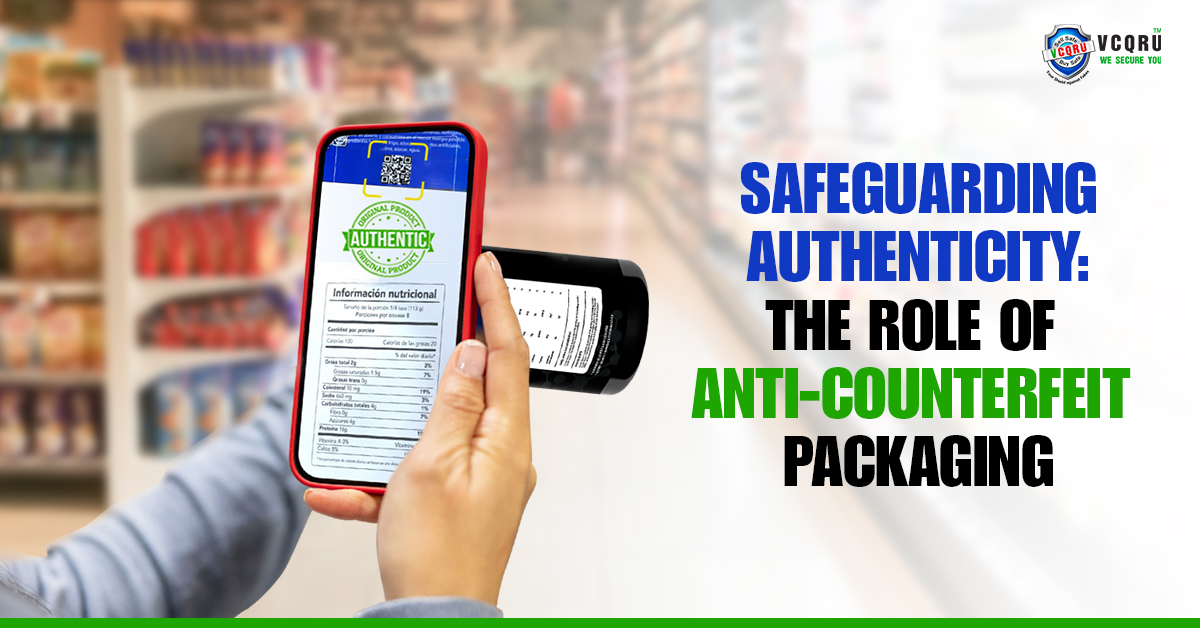

Counterfeiting is a widespread issue affecting various industries, including pharmaceuticals, electronics, luxury goods, and more. Due to this counterfeiting threat businesses are losing in the billions annually. It not only undermines brand integrity but also poses significant risks to consumer safety and health. To combat this issue, businesses are increasingly turning to anti-counterfeit packaging solutions. In this article, we delve into the concept of anti-counterfeit packaging, its importance, and methods of implementation.
Anti-counterfeit packaging refers to the integration of security features and technologies into product packaging to authenticate and protect against counterfeiting. Its primary goal is to prevent unauthorized replication and ensure the integrity of genuine products. Anti-counterfeit packaging techniques encompass a wide range of technologies and features, including but not limited to unique identifiers, tamper-evident seals, holograms, RFID (Radio-Frequency Identification), QR codes, and covert markings.
Unique Identifiers: Incorporating unique identifiers such as serial numbers, barcodes, or digital watermarks enables manufacturers and consumers to authenticate products. These identifiers are often integrated into packaging labels or directly onto the product itself.
Tamper-evident seals provide visible evidence of product tampering or unauthorized access if a product has been compromised. These seals are designed to break or show signs of manipulation upon opening, alerting consumers to potential counterfeit products or tampering attempts.
Example:Over-the-counter medications often feature tamper-evident packaging, such as blister packs with foil seals or shrink bands around bottle caps. These packaging designs help consumers identify unaltered products and prevent the consumption of tampered goods.
Holographic stickers and security labels are visually striking and difficult to replicate, making them effective deterrents against counterfeiters. These labels often include intricate designs, microtext, or dynamic effects that enhance security and authenticity.
Example:The pharmaceutical industry widely utilizes holographic labels on medication packaging to authenticate products and prevent tampering.
RFID tags embedded in packaging enable real-time tracking and authentication of products throughout the supply chain. These tags contain unique identifiers that can be scanned using RFID readers, allowing manufacturers and consumers to verify product authenticity and monitor the movement of goods, mitigating the risk of counterfeiting.
Example:Fashion brands like Gucci and Louis Vuitton embed RFID tags in their luxury goods to combat counterfeiting. These tags facilitate product authentication and enable brands to trace the movement of genuine products, enhancing supply chain visibility.
QR codes printed on packaging can be scanned using smartphones to access product information, verify authenticity, and report suspicious activity. Mobile authentication platforms empower consumers to participate in the fight against counterfeiting by providing instant verification and reporting mechanisms.
Invisible ink and UV printing technologies enable covert authentication of products. Invisible ink markings or patterns are only visible under ultraviolet (UV) light, providing an additional layer of security against counterfeiters.
Example:Spirits manufacturers use UV printing techniques to apply invisible markings on bottle labels or caps. These markings are invisible to the naked eye but become visible under UV light, allowing authorities and consumers to verify product authenticity.
The adoption of anti-counterfeit packaging has far-reaching implications for both businesses and consumers. By instilling trust and confidence, it fosters brand loyalty and enhances customer satisfaction. Additionally, it helps governments and regulatory bodies in their efforts to combat illicit trade and protect public health. Overall, anti-counterfeit packaging contributes to a safer, more secure marketplace for all stakeholders involved.
Counterfeit goods can pose serious health and safety risks, especially in sectors like pharmaceuticals and food. Anti-counterfeit measures such as tamper-evident seals and track-and-trace technologies help ensure product safety and protect consumers from harmful substances.
Counterfeiting not only impacts brand reputation but also results in substantial revenue losses for businesses. Effective anti-counterfeit packaging helps deter counterfeiters and protect market share, thereby safeguarding revenue streams.
In the pharmaceutical sector, anti-counterfeit packaging plays a critical role in ensuring patient safety and maintaining the integrity of medications. Companies like Pfizer and Johnson & Johnson have implemented advanced serialization and track-and-trace systems to combat counterfeit drugs.
Luxury brands such as Louis Vuitton and Rolex invest heavily in anti-counterfeit measures to protect their brand reputation and intellectual property. High-security holograms, RFID tags, and bespoke packaging are among the strategies employed to authenticate luxury products and thwart counterfeiters.
Food and beverage companies utilize anti-counterfeit packaging to safeguard product authenticity and prevent food fraud. QR codes, tamper-evident seals, and blockchain technology are increasingly used to trace the origin of ingredients and ensure product integrity.
Anti-counterfeit packaging plays a crucial role in safeguarding brand integrity, ensuring consumer safety, and combating revenue losses associated with counterfeiting. By implementing robust technologies and strategies, businesses can protect their brand reputation, safeguard consumer safety, and uphold regulatory compliance. As counterfeiting techniques evolve, continuous innovation in anti-counterfeit packaging remains essential to stay ahead of counterfeiters and preserve trust in brands and products.
For any queries feel free to contact us and our expert support team will get back to you as soon as possible!

A unique online presence is a key factor for magnified business growth. In today’s era where 85% of the population uses social media, your brand, and your business must be able to connect with your target audience in no time. Online marketing strategy is referred to advertising delivered through digital channels to promote brands and connect potential customers using the internet and other forms of digital communication.
April 10, 2023You may need to provide clients a cause to keep buying from you on occasion, stirring your pot of profits. Businesses provide special discounts to clients who make frequent purchases in order to promote customer loyalty. This well-executed art is known as a loyalty programme.
Mar 15, 2023Pipeline Construction is a dynamic industry that continues to grow and
SEPTEMBER 26, 2019